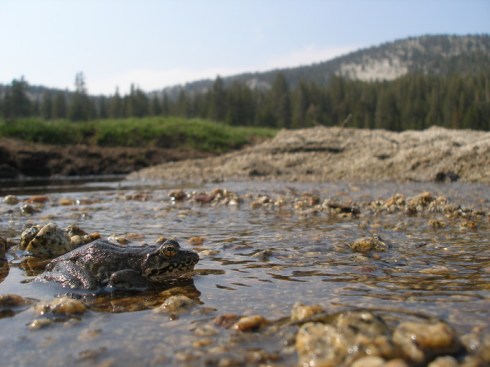
Sierra Nevada yellow-legged frog. (Photo/Devin Edmonds, http://www.amphibiancare.com)
Most people consider loyalty an admirable trait, but for the Sierra Nevada yellow-legged frog, faithfulness to a compromised breeding ground just might spell doom for the species. In many places, the frog’s habitat is drying up or swarming with ravenous introduced trout. A new study released by the USDA Forest Service in the Canadian Journal of Fisheries and Aquatic Sciences details the extent of this troubled relationship, and provides insights key to giving the frog a chance at survival.
Mountain yellow-legged frogs, (of which there are two species), adapted to live in high alpine lakes, in environmental extremes too cold and harsh for most amphibian species. This specialty helped the frogs thrive, but in the past century, the once common Sierra Nevada yellow-legged frog has disappeared from more than 90 percent of its range. In 2003, the U.S. Fish and Wildlife Service ruled that the mountain yellow-legged frog “warranted” endangered species listing, but was precluded due to the need to list more high priority species.
Likely culprits for the frog’s decline include the usual suspects like disease and contamination, but new research shows that the periodic drying up of habitat and predation from introduced trout coupled with the frog’s loyalty to specific breeding spots is pushing the animal ever closer to extinction.
Yellow-legged frogs need up to four years for their tadpoles to mature. So if a pond dries up, the species could lose up to four year-classes of offspring, issuing a serious blow to that particular population. The study also found that for some of the best ponds left for the frog, introduced trout then threaten the species. Offer a trout a yellow-legged frog and it won’t turn you down, no matter what the life stage of the dangling amphibian.
Kathleen Matthews and Haiganoush Preisler, scientists with the USDA Forest Service’s Pacific Southwest Research Center, conducted a 10-year study to measure the fidelity of yellow-legged frogs in Kings Canyon National Park, east of Fresno, Cali. They used mark-recapture techniques, and observed frog tendency to return to lakes even for locations that tended to dry up in low snowpack years, or where frogs had previously encountered predatory fish.
Fish removal appears to be a strong restoration technique, and projects underway show a rebounding in the order of tens of thousands of frog and tadpole populations in lakes where non-native fish have been eradicated. There may just be a little bit of hope yet for the garrulous hoppers, especially if restoration efforts incorporate knowledge of site fidelity into their tactics.
You can learn more about the natural history and restoration efforts behind this little frog at MYLfrog, or download the USDA Forest Service study here.

